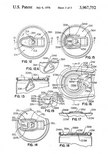day by day: a blog
July 26, 2007
Names
 The problem: "Large numbers of containers, particularly beverage cans, are conventionally opened by pulling off a tear strip which is removable together with the attached ring tab. The severed tear strip with attached tab may be carelessly discarded with undesirable consequences, such as litter and a hazard to bare feet. Moreover, many cans with easy-open ends of this sort are made of aluminum alloys which can be produced with less expenditure of energy through recycling than from the original ore, and the metal in the tear strip and tab are more readily collected and recycled of the tear strip and tab remain with the can body after opening of the can."
The problem: "Large numbers of containers, particularly beverage cans, are conventionally opened by pulling off a tear strip which is removable together with the attached ring tab. The severed tear strip with attached tab may be carelessly discarded with undesirable consequences, such as litter and a hazard to bare feet. Moreover, many cans with easy-open ends of this sort are made of aluminum alloys which can be produced with less expenditure of energy through recycling than from the original ore, and the metal in the tear strip and tab are more readily collected and recycled of the tear strip and tab remain with the can body after opening of the can."
The solution: "the invention provides constructions wherein the tab for opening a panel in a container wall is capable of having one end pressed against the panel to open it wide without putting the tab in a position where it will obstruct more than a small portion of the opening left by the panel in its open position. Furthermore, the tab nose is positioned in accordance with the invention away from any rupturable score line, thereby reducing the chances of inadvertent rupture through pressure on the tab during storage and transportation. The invention further teaches initiation of rupture of the score line adjacent the rivet or the like securing the tab to the container wall, and completing rupture through propagation of the initial crack away from adjacent the rivet position and then around and back again to leave only a small unbroken part of the wall to hinge the panel. The means securing the tab to the container wall is secured to the wall outside the area of the removable panel, with some play preferably provided to permit the liftable end of the tab to be raised conveniently preliminary to initial rupture of the score line.
"The opening construction of the invention requires a tab which must be stiff against transverse bending and yet flexible and tough enough at the connection between the tab and end wall to permit lifting and retracting the tab without causing a fatigue crack at the connection. The invention provides a tab construction meeting these requirements. It is particularly adapted to be used in conjunction with the applicant’s novel opening construction, but may also have application in other opening constructions."
This is from U.S. Patent 3967752 [thanks, Google], filed in November 1975, for Daniel F. Cudzik's now all-but-universally-dispersed invention of what the patent calls the "Easy-Open Wall" in a soda can, or, in everyday parlance, the "stay-top". It's that little rivetted lever and the adjacent aluminium flap in the roof of your soda can. I like very much the notion alluded to in the patent that the proper use of this device is so ingeniously self-evident that it can actually "teach" even neophyte purchasers of a beverage how to penetrate into the otherwise relatively durable and self-contained object in their hands. When you pull up the lever the seal is broken and the flap drops like a miniature trap-door, allowing you access to your soda. By the way, I'm still working on the Diet Coke whose stay-top I popped just a few minutes ago while beginning this post.
The question I find myself asking is — We know that patent descriptions are highly complex, artful texts. They must be specific enough to define very intimately the unique nature of the invention for which a patent is claimed, while being at the same time, in order to ward off bucaneering rivals, inexplicit enough to withhold some crucial details about how exactly this invention can be reproduced or manufactured. But could you describe the construction of that small verbal object a poem as lucidly, exhaustively, fully and, in its awkward way, as beautifully as this patent's language does the construction and functioning of the stay-top? My answer on all counts is — unfortunately, No. But it is my ambition to reach the level of competence where, in writing about poetry, I can produce at least an approximation of such fine-grained precision.
Cheers! Drink it up!
Posted by njenkins at July 26, 2007 07:56 PM
With the exception of interspersed quotations, all writing is © 2007-09 by Nicholas Jenkins